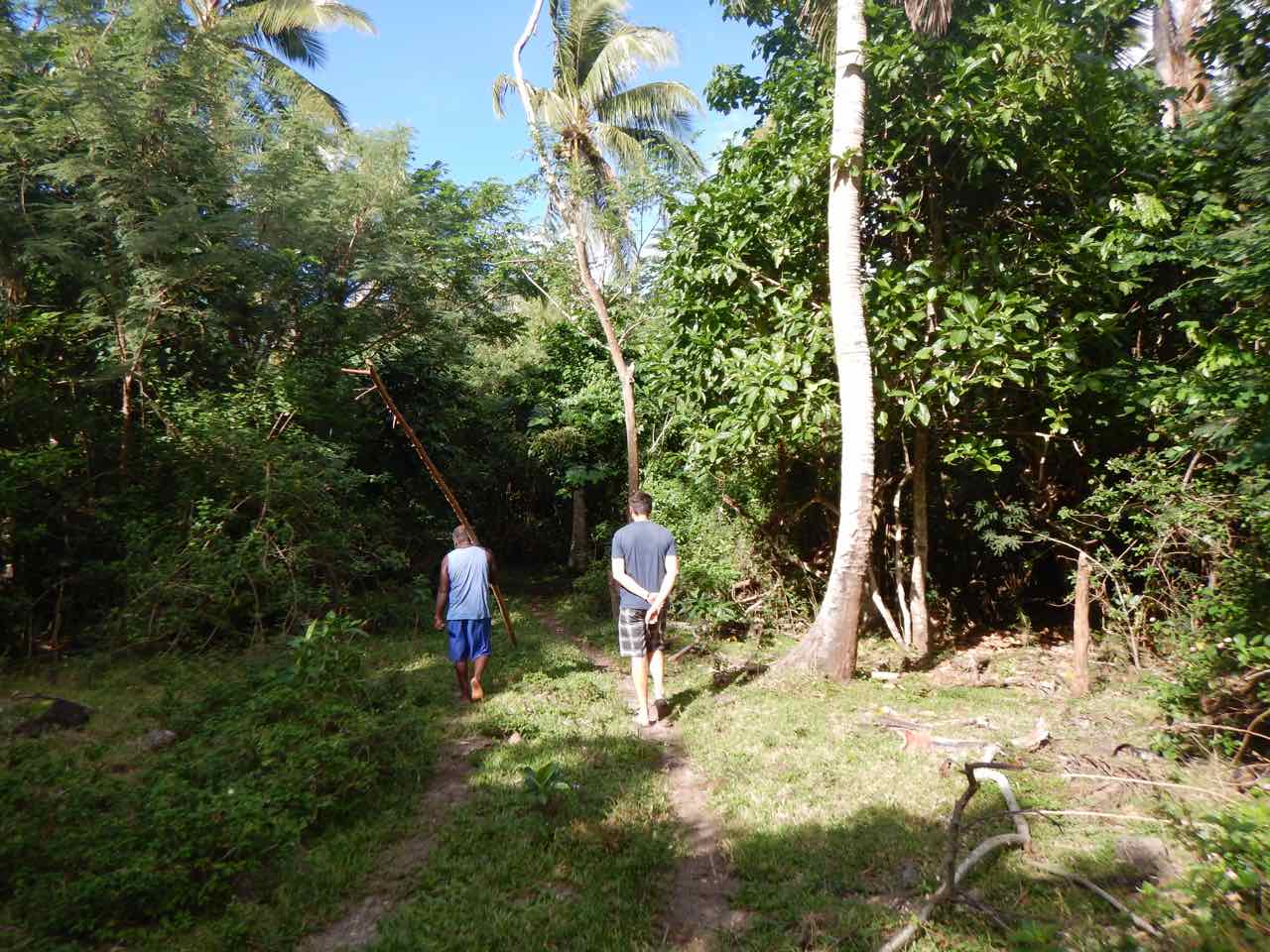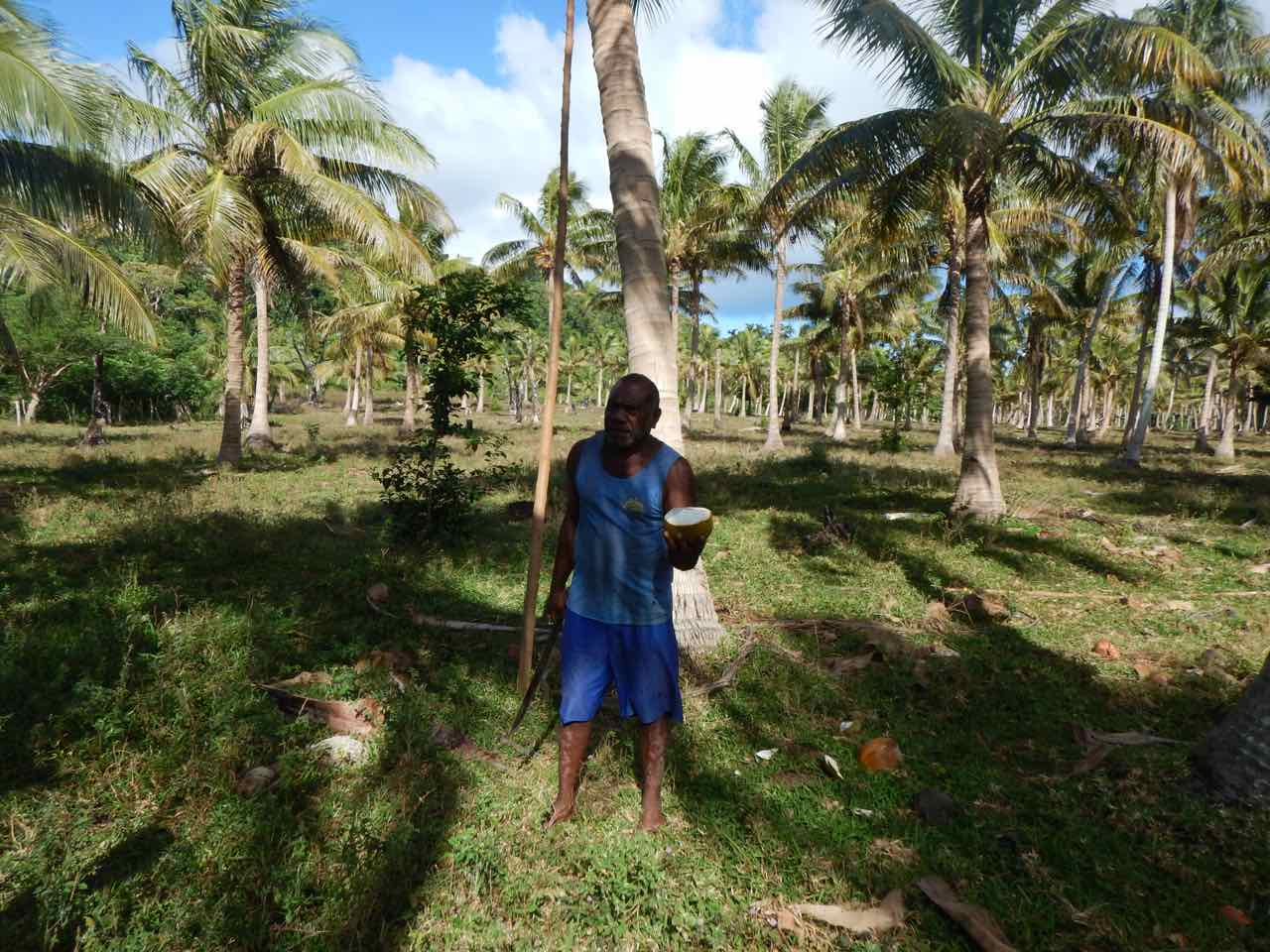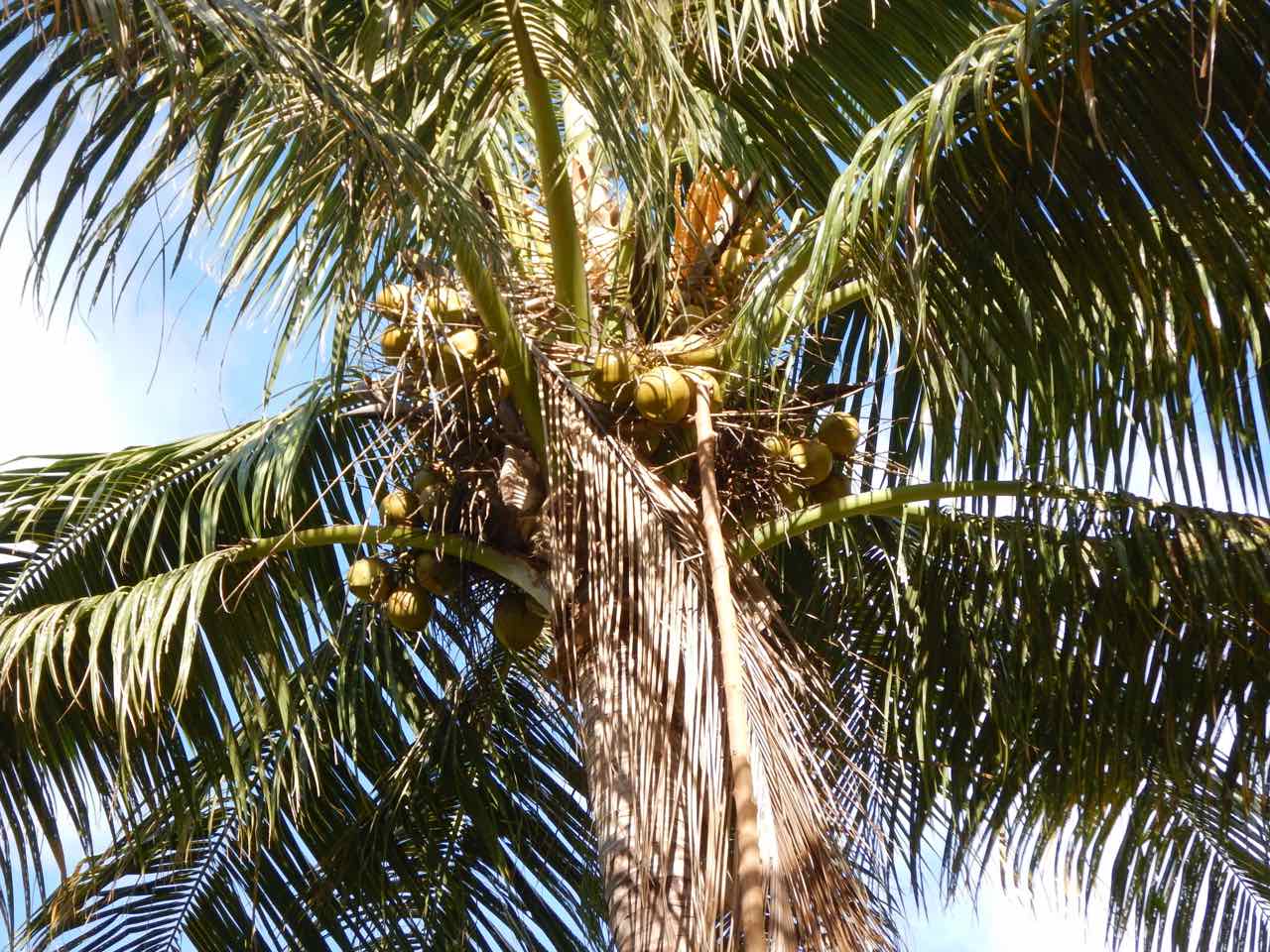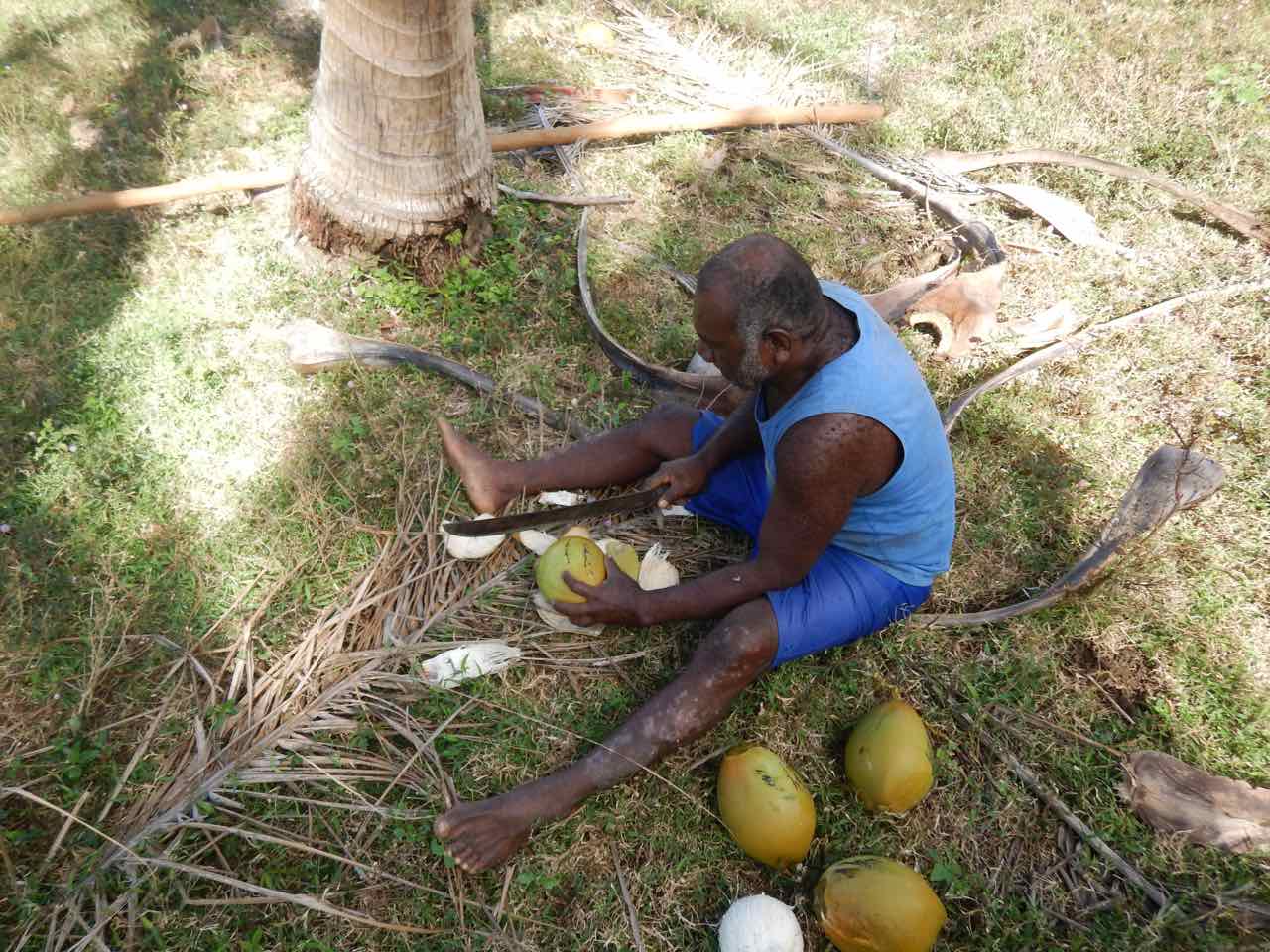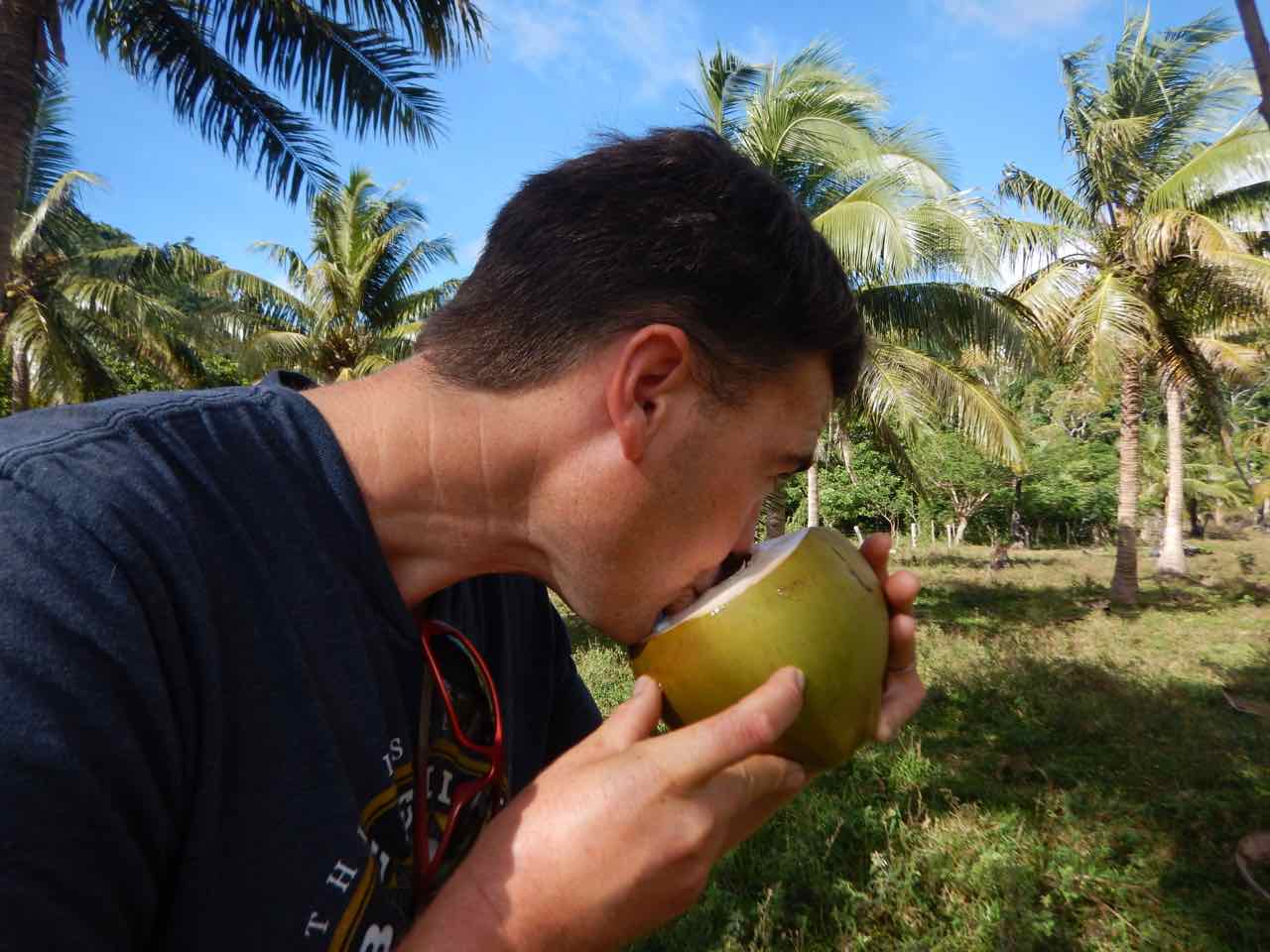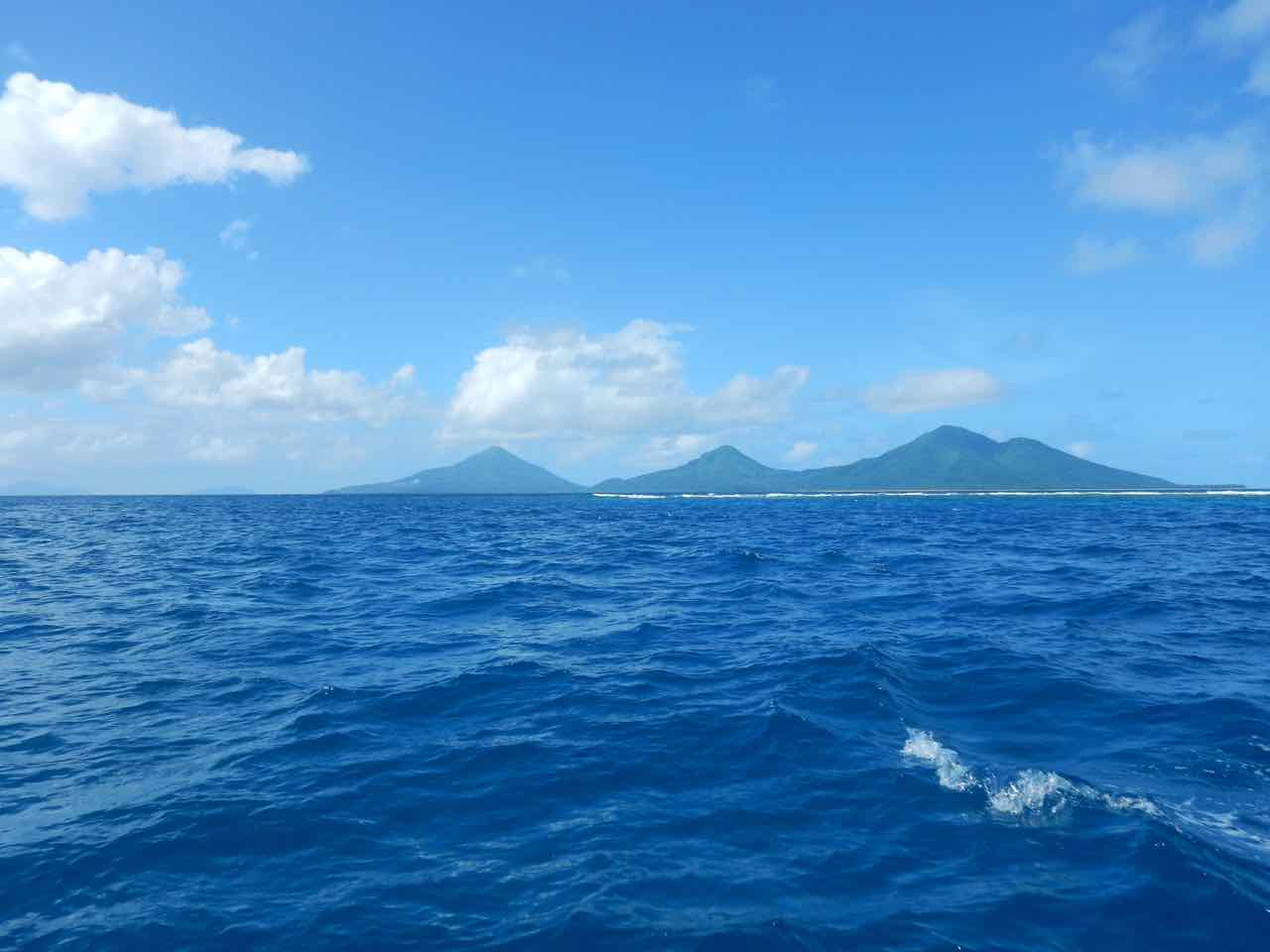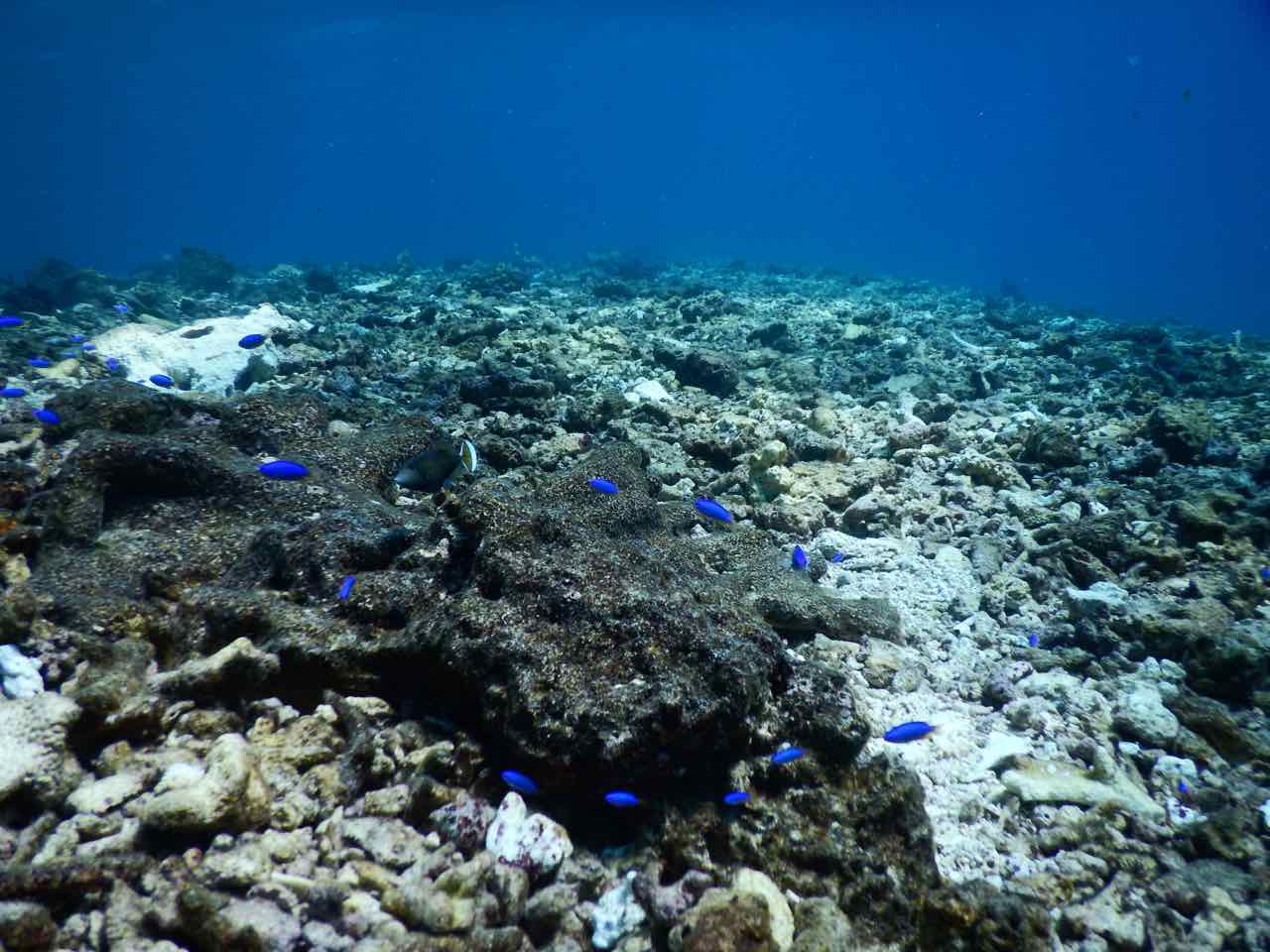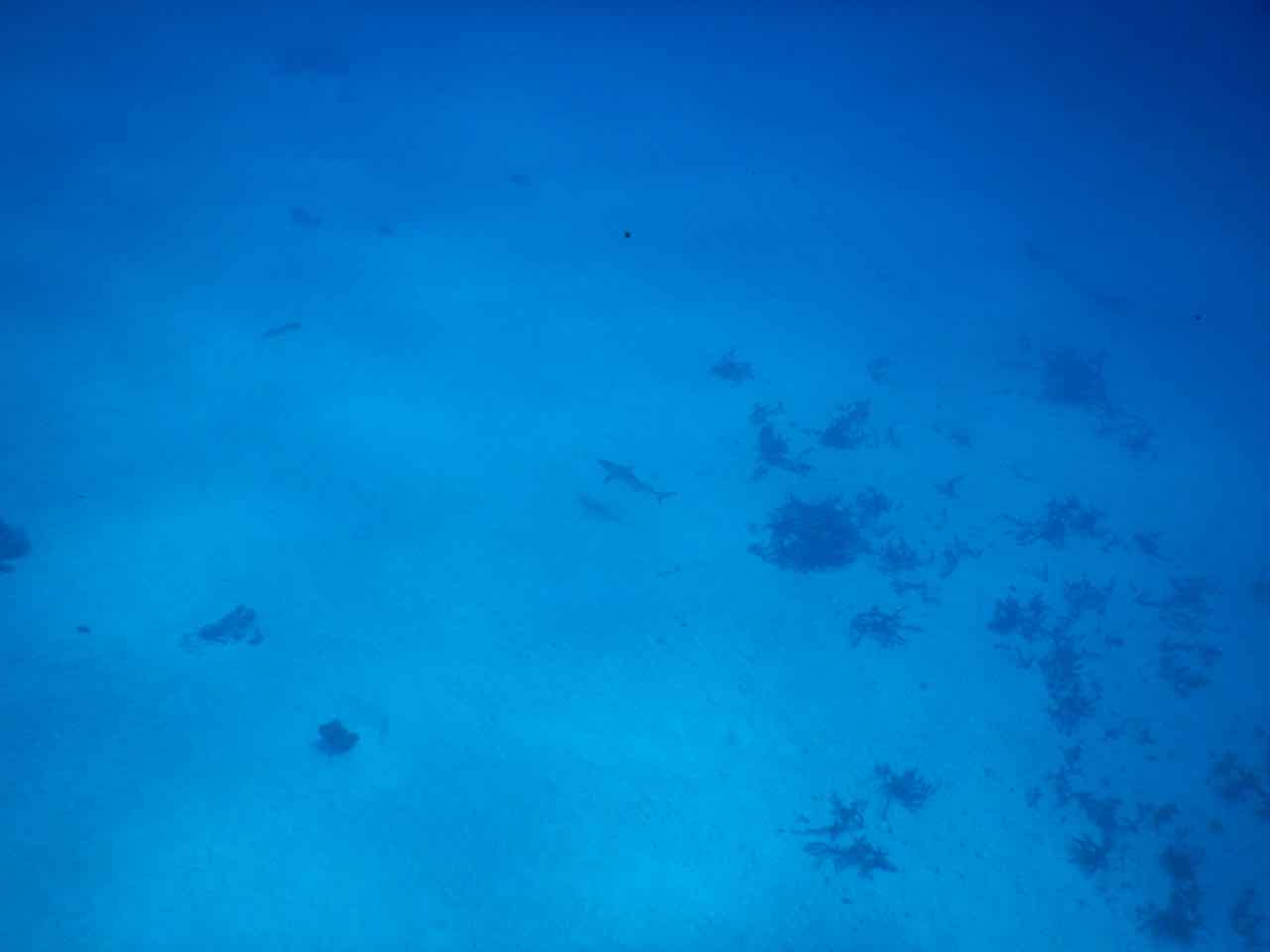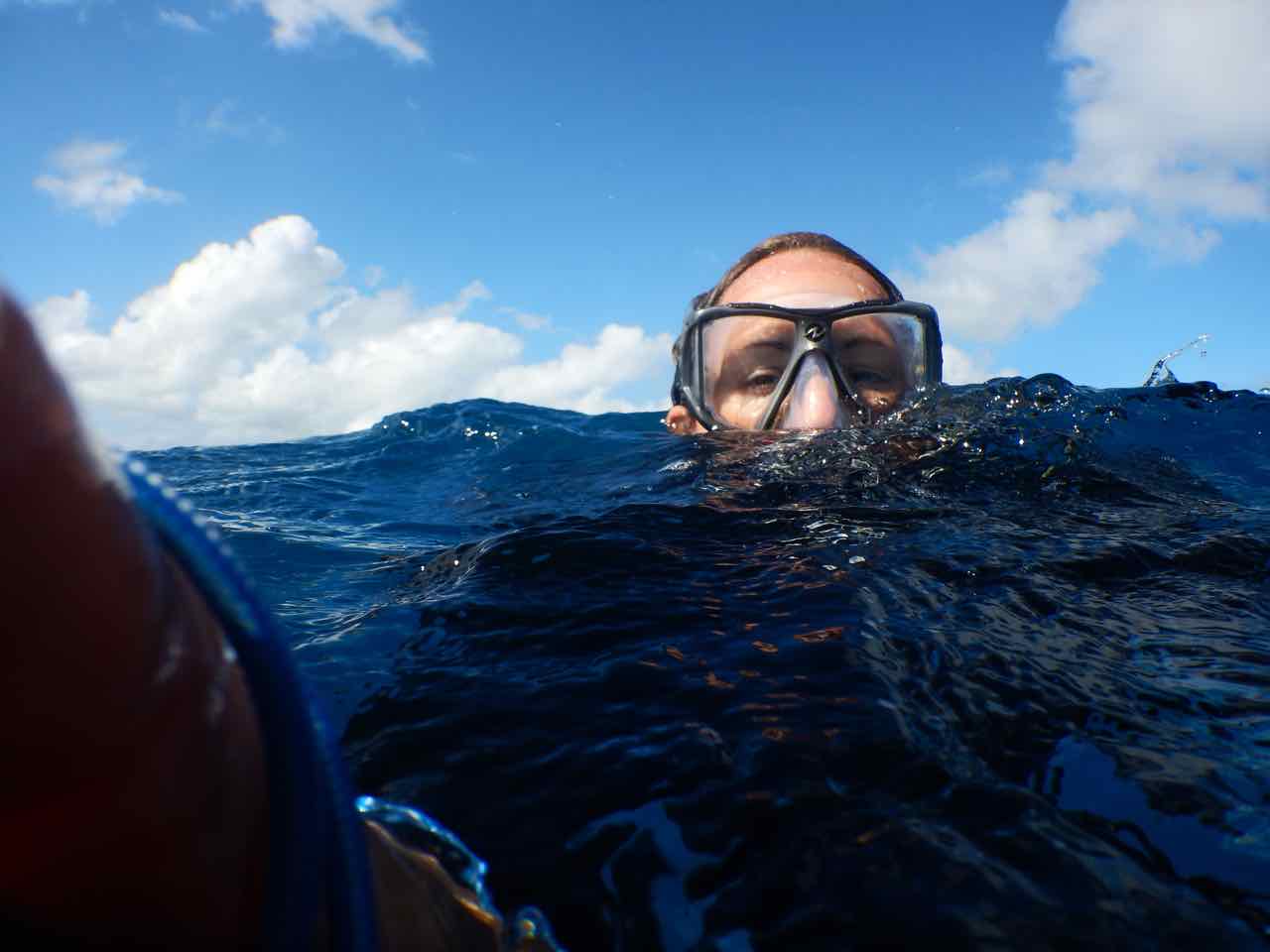The wind was piping, and the islands blocked the big waves on our sail from Efate to Emae. Sonrisa averaged six knots; it felt like we were riding a magic carpet the whole time. It was a pretty fun sail. We anchor for the night just off the West side of the island. The stars are out, and it is a pleasant, cool sleep.
When we wake in the morning, we put Grin together and head to shore to do what the guidebooks say we must: meet the village and ask for permission to swim on the reef, scuba dive Cook Reef if the weather permits, and generally just say hello. Jim is waiting for us on the beach as we arrive.
He beams his perfect smile and offers an outstretched hand. “Hi, I’m Jim! What is your name?”
We stand on shore and he asks us a few questions about Sonrisa, our sail, last night’s snooze in the anchorage. “Do you like coconuts?” We say sure, and he invites us to walk inland to the plantation to fetch some green coconuts. He explains we can walk 10 or 15 minutes to the village on the other side of the island. He and his “father” and brothers have leased this land from the government to farm. They grow yams, manyuk, kumara, coconut, and papaya, to send back to the market in Port Vila. They also raise the delicious Vanuatu beef we have been so enjoying.
As we walk the trails, cows eye us with scorn. “I think they can smell all the beef we have been eating.” Andrew whispers to me. But, the cows make no move for retribution.
Just before we enter the plantation, Jim cuts down a young tree with his machete. He clears the branches and makes a nice poking stick, leaving two branches in the shape of a “Y” at the top. We approach a coconut tree, and he inspects the coconuts to determine if these are ripe. He pokes at one with the stick, it falls, cracks open and water spills out. “No, this one isn’t ripe enough.” We move on to two more trees.
Finally, he finds a group he likes. He pokes and pokes at them. When one falls, he dodges left or right to be avoid being hit. Soon, we have a group of six on the ground. Methodically, he slices the bottom off the coconut, then slices vertically, opening the protective covering of the coconut in a shape of a flower. Once each of the sides are off, he pulls out the coconut itself, shapes the stem into a tidy little handle, and adds the coconut to our pile. He is swift and efficient, and before we know it, all six coconuts are cleaned and ready to go in our fridge. He looks at the pile. “Are you sure you don’t want more? Maybe ten?” We agree we would like ten. He pokes down two more, cleans them, and adds them to the pile. We gather them up in our arms and move them to a log on the side of the road, to be retrieved on our way back after we go to the farm.
At the farm, Jim instructs us to sit and wait. He squeezes through a barbed wire fence, presumably to keep the cows out, then returns a few minutes later with a woven basket full of papaya for us.
“Do you have any extra sunglasses on the boat?” He asks. I think over Sonrisa’s inventory, and the only extra sunglasses I can think of are the Don & Garys. Oh no, not the Don and Gary’s!While most sunglasses come and go as a result of diving into the water with them on my face or some other calamity, Don & Gary have been a stalwart part of the family since 2009. I believe it was a late season sailing race on Lake Mead that I realized I had forgotten to bring along my good sunglasses. Going through the vertical rack in the Lake Mead convenience store, I found some acceptable substitutions for $10.00. “Polarized!” The sticker said. On the side arm, “D & G” are affixed in shiny silver letters. As we climb aboard Heeling Art to ready ourselves for the race, the team admires my new “Dolce & Gabana” shades.
“Naw,” I laugh. “These are more like Don & Gary!” And the name stuck. The Don & Garys sailed many a Nevada Yacht Club race, joined us for weekend cruises on Winchime, moved aboard Sonrisa in 2012 and are still here!
But, Jim needs sunglasses, and we have some sunglasses. I suppose it is a worthy honor for Don & Gary to help Jim out. I’m sure he will take good care of them, anyway.
As we head back to the boat, we go to gather up our coconuts and find the cows have moved in for their revenge after all. They are placidly munching away at the “handles” Jim so carefully carved in our coconut husks. Jim yells at them and throws an old coconut at their general direction. Startled, they look at us with hateful eyes, then sidle sideways away from the coconuts. One cow carrying a coconut away in her mouth. Jim apologizes and asks if we want new ones, but Andrew declares “They are still good, just a little ‘cow eaten!’”
Jim shrugs.
Is it just me, or does that cow look a little sheepish?
Back at the beach, we meet a man Jim refers to as his “old man.” When I ask the guy if he is Jim’s father, he says something about higher rank that I did not understand. Family relationships are still such a puzzle to me in these countries. Are they related in the traditional sense or not? Jim’s father explains they are looking to develop a tourist destination in the bay, and they are looking for investors. They give us a keen eye, but we are not in the tourist villa investment market. Jim’s father seems disappointed, but Jim is not dissuaded. He asks if he can come with us to see the boat.
I don’t get any creepy vibes, so we welcome Jim into Grin and shuttle him out to Sonrisa. Aboard, he comes downstairs for a look, and we offer him coffee. He smiles and nods, but when Andrew breaks out the coffee bean grinder, he stands up and watches intently. As Andrew finishes grinding, he takes the grinder off the top of the collection jar and sets it aside. Jim picks it up and looks at the bottom, trying to figure out how it works. He gives a little laugh and a smile, then shakes his head as if to say “amazing!” We serve his coffee, with milk and sugar. Then, he discovers the spoon we left in the cup to let him stir. The stainless steel handle glistens above the steaming hot liquid. He lifts it out of the mug, balancing it between his thumb and forefinger. He lofts his hand a little, once, twice; as though he is feeling the weight of the spoon. He turns it around in the light coming through the hatch. Again, he just smiles and shakes his head. He stirs his coffee.
I produce the Don and Garys. He gives them a good look, then pops them on top of his head.
We chat and talk. When we ask him about tide times for Cook’s Reef, he tells us it’s a good time to go. “Would you mind if I joined you?”
“I don’t know, Jim.” The smile fades for a minute. “Will everyone back at the village think we are kidnapping you? Are they going to send a search party?”
“Naaawwwwooooo!” He hoots, laughing a good belly laugh.
So, we up anchor. He follows Andrew on deck watching how everything goes. Back in the cockpit, he has a million questions about how things work. How fast does Sonrisa go? He sees me at the helm and points. “Are you the Captain!?” He asks, incredulous. I tell him Andrew is the Captain and I am the helmsperson. “You look like the Captain to me.”
For a moment, he drops the Don & Garys over his eyes, takes a look around in the sun, then shoves them back up on his head again.
Sonrisa is calm and stable on the way out to the reef. It is a downwind sail, so she glides along flat in the water. The island blocks all the waves, and it is a comfortable ride. Jim stands in the cockpit, squinting to the horizon, holding on to the dodger and the bimini. I worry a little about him falling overboard, but I remind myself that these are the people who can balance one footed on the front of a log canoe or walk along the incline of a tipped over palm tree as though they are walking down Las Vegas Boulevard. He probably won’t fall overboard.
We arrive at the reef and cautiously weave Sonrisa through the coral bommies that jump from1000 foot deep sea to the surface. Andrew and I both silently question the sanity of driving our floating home into an unprotected reef in the open ocean. We find the sand patch described by the guides and the charts, and drop Sonrisa’s anchor. Andrew gives me hand signals to move right or left, forward, neutral, light reverse. Jim stands just behind Andrew on the bow, watching the process unfold with wide eyes moving back and forth between Andrew at the bow and I at the helm.
Unfortunately, the wind and waves are still up and Sonrisa bounces around on her anchor. In a perfectly calm day, we might have been willing to drive Grin the mile+ it would take to exit the reef, drive the the side with the best dive spot, duck under water for an hour, and then return. Today, it feels too risky to leave Sonrisa alone and too risky to drive ourselves into wavy open ocean with nothing but Grin and 5 horsepower Kitty. So, instead, we hop in and snorkel around on the inside of the reef.
“Do you want to swim, too?” I ask Jim.
“No! Too cold for me!” He explains. I laugh. It is winter, here.
The reef is broken and grey from all the waves that crash into this spot on wild ocean days. We see a small reef shark, a sting ray and some little blue fish, but that is about it. When we return to Sonrisa, we find Jim, stretched out on the foredeck with his hands crisscrossed behind his head. Eyes closed, Don & Gary still on his forehead. The look on his face says: “This is nice!”
As we climb aboard, he sits up and smiles. “What did you see?” We give him the report.
Then, we gather up Sonrisa’s anchor and head back - upwind. Sonrisa is crashing through the waves, shooting spray sideways beneath her bow. The wind is strong, so she leans into her heel like a swimmer rolling her body sideways to take a breath. Jim is sitting on the low side, next the working winch. The ropes tightening the sails in creak and groan with the strain of the wind - a sound Andrew and I don’t even hear anymore because it is so familiar. Jim looks at me with wide eyes and points at the rope. “Eeeyiiii!?” He says.
“Yeah, don’t worry. It is supposed to do that. Lots of pressure in the sails!”
“Lots of pressure!” He repeats for emphasis.
Just like any new sailor on the boat, I can feel him watching me - taking his cues about whether everything is okay. He’s not so much worried as just uncertain. I tell him she is supposed to tip sideways, too, and he nods.
Soon, it is time to tack. We explain we have to move the sails from one side to the other, and there will be a moment where the sails will flap around a bit. It will be loud. “Do you want to help?”
He nods, so I explain how to let the sail loose. “Hold on until I say when, then take the rope completely off the winch. Don’t hold on, just let your rope fly loose.”
“Okay,” he says, a look of concentration on his face.
“Ready about!” I say, turning Sonrisa’s helm hard to port. There is a moment where everything stops and slows down, she flattens out, then tips over to her port side. The sails back fill, meaning the wind pushes them over to the other side.
“Okay, let go!” I tell Jim. He unwinds his rope and watches as the sails flap, flap, flap and Andrew pulls in on the other side. The winch sings as its little metal cogs click against each other in quick succession. Soon, all the sails are on the other side, we are tipped the other way and Sonrisa is making quick way.
“WOW!” Jim says.
A few miles later, we tack again. This time, Jim gets to pull the sail around. We go through the same process, he pulls and pulls. I had him the winch handle to help him finish tightening the Genoa, and we are back underway.
He smiles. “I could do this! Give me a few more days to learn.”
“Absolutely,” I say. “Islanders are the original sailors anyway, aren’t they?”
He smiles. “Yeah, true! But not boats like this.”
I tell him they are all basically the same idea.
As we near the island, I put my hand over my eyes to shield the sun. Looking off in the distance, I say: “JIM!”
“What?” he says looking in the direction of my gaze.
“I think I see a search party forming on the beach!”
He laughs and laughs again. “Naaawwwoooooooo!”
Eventually, Andrew loads Jim into Grin to take him back to shore. Jim squints up at me through the glare of the sun. “I like your shades, Jim. Looking good.” I tell him, and wave. He pats them on his head, and smiles.
“See you when you come back!” He calls, waving back at me.


